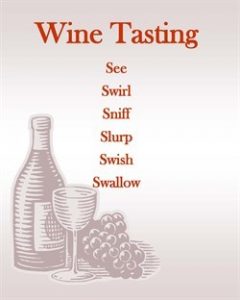party in the backyard. Wine gatherings, with tasting cards and/or note taking, are a great way to learn some new things about wine and the process of tasting, comparing, and appreciating it.Don’t worry; a formal (or serious) wine tasting isn’t all that formal. Wine tasting doesn’t have to be what you’ve seen in the movies; a bunch of snooty, ascot wearing men with exaggerated British accents, swirling wine.
 Here’s a List of Things You’ll Need:
Here’s a List of Things You’ll Need:
- Bottles of wine
- Corkscrews
- Wine glasses
- Spit/dump bucket (no worries, you’ll enjoy your favorite after the tasting)
- Water pitcher
- Bags or foil to cover up the bottles
- Palate cleansers (bread or plain crackers)
- Wine Tasting Score Card or Mat (we have included a sample for you)
Stand Up or Sit Down?
When planning your party, you’ll need to decide on your guest list early. Most likely, the number of guests you have will decide if your party will be a stand up or sit down event. With a sit down tasting each guest has a tasting mat and records their findings on either the mat or a tasting card.
We’ve put together this mat for you that you can download here:
Choosing the Wine:
The wines for your tasting must be similar, yet have a distinct quality (or ingredient) that sets them apart. Ideally, the wines will be different enough so that even folks who claim that they can’t tell wines apart, will be able to; and seasoned wine-lovers will be able to identify subtle flavors. This is usually where novice tasters get excited; learning to really taste the wine with all of their senses.

In order to select your wine offerings, you’ll need to establish what kind of tasting you’re hosting.
Vertical Tasting: A vertical tasting involves wines from different vintages (harvest years) from the same winery. Meaning, you would select a single wine from that winery and taste different vintages of that wine. A vertical tasting teaches you more about differences between different vintages, rather than the differences in wineries.
Horizontal Tasting: This tasting compares wines from the same year but from multiple vineyards. For comparative reasons, choices are typically limited to the same type of grape and region. A horizontal tasting allows tasters to compare the differences in in wine making styles.
“Top 8” Varietal Tasting: This is a tasting where you taste the various top varietals: Cabernet Sauvignon, Pinot Noir, Merlot and Syrah/Shiraz (reds) and Chardonnay, Riesling, Sauvignon Blanc and Pinot Gris/Pinot Grigio (whites). For this tasting, you may stay within one country, or even vineyard, or try wines from different regions or countries. This is a great way to learn not only your preference between white and red wines, but types of whites and reds you prefer.
Helpful Tips:
- Plan on each guest having the equivalent of a total of 2-3 glasses of wine. A bottle has about 4-5 glasses of wine, so with a little math, you can figure out how much wine to buy. This will easily cover the tasting aspect; you may want a few extras for your guests to enjoy a full glass of their favorites after the tasting is concluded.
- The 20/20 rule: Open red wine 20 minutes before serving to allow the wine time to breath, and remove white wine from the refrigerator 20 minutes before serving, so that it’s not too cold.
As with any backyard gathering, a wine tasting party is unique way to invite friends over for a night out on the patio during the fall months.